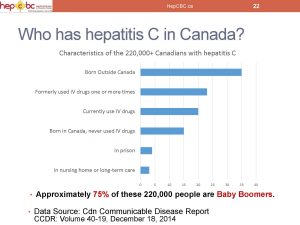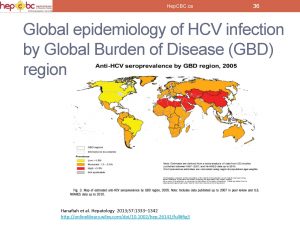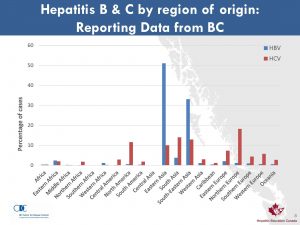This page is an archive. Its content may no longer be accurate and was last updated on the original publication date. It is intended for reference and as a historical record only. For hep C questions, call Help4Hep BC at 1-888-411-7578.
Who has hepatitis B and hepatitis C in Canada? In order to eliminate viral hepatitis, it is very important to know the answers to this complex question!

Looking at Canada’s hepatitis C statistics, the largest group of people with hepatitis C is made up of people born outside Canada, followed by former users of IV drugs, then by current users of IV drugs (PWID). Hepatitis B and C are spread through blood-to-blood contact, so IV drug use is a logical risk factor. But why are people born in some other countries considered at risk? Blood and blood products were tested for hepatitis B and C later in some countries than others. Many people, including countless children, were infected with hepatitis C during mass-vaccinations or by tainted blood before it was tested. Medical and dental equipment (including dialysis) as well as blades or needles used in traditional practices such as circumcision, acupuncture, scarification, tattoos, and phlebotomy can transmit if re-used (and not thoroughly sterilized with an autoclave).

This does not mean that being an immigrant is a hepatitis C risk factor, or that people born in Canada are safe from catching it! However, anyone who has spent time either as a tourist or resident in a country where hepatitis C is endemic should be tested. Note that 1 in 20 infants born to hepatitis C-infected moms develop the disease, so the next generation should consider testing as well..

The good news is that hepatitis C is curable now! Most people with hepatitis C can now be cured in a matter of weeks with new highly-effective, all-oral treatments that, in most cases, have almost zero side effects. And, the new treatments are now covered by all provincial and territorial PharmaCares. Once a person is cured of the hepatitis C virus, liver damage stops, and in most cases the damage starts slowly reversing.

If we look at the statistics of HCV among immigrants in Canada, and specifically in BC, we should look at three figures in particular, the “HCV %” and “N HCV Canada” and “N HCV BC” columns. “HCV %” shows the prevalence of hepatitis C in a particular group. You can see the highest prevalence (in 2013, at least) was 6.1 % in the Vietnamese population. The “N HCV Canada” column shows the number of people living with hepatitis C in Canada in a particular group. You can see the groups in Canada with the greatest number of people with hepatitis C are China (18,738), Philippines (18,083) and India (15,742). And the “N HCV BC” column shows the number of people living with hepatitis C in British Columbia in a particular group. You can see the groups in BC with the greatest number of people with hepatitis C are China (5710), India (4040) and Philippines (3761). Note these are old figures, based on surveys back in 2013. Also, there is a big difference between “reported cases” and actual prevalence, so they are simply “educated estimates” of the actual total.

Finally, let’s add in some statistics that include hepatitis B! Thanks sincerely to the BC Centre for Disease Control and Hep Education Canada who have collected and presented both this data and the data in the previous chart. This shows that hepatitis B appears to be a far greater problem than hepatitis C in most immigrant countries, especially in Asia and Africa. Hepatitis C is a larger problem in countries of North and South America, Europe, and Oceania (including Australia).
To find out more about HepCBC’s viral hepatitis B and C outreach to newcomer and immigrant communities, click HERE.
For translations of viral hepatitis B and C materials into many languages, click HERE.
